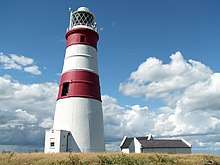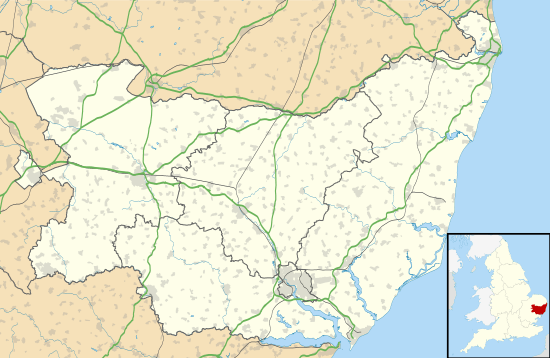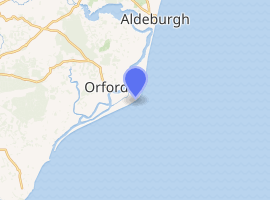Orfordness Lighthouse
Orfordness Lighthouse is a decommissioned lighthouse on Orford Ness, in Suffolk, England. The 30 metres (98 ft) tower was completed in 1792. The light had a range of 25 nautical miles (46 km; 29 mi).[2] It was equipped with an AIS transmitter with MMSI 992351016.[3]
 Orfordness Lighthouse | |
 Suffolk | |

| |
| Location | Orfordness Suffolk England |
|---|---|
| Coordinates | 52.083940°N 1.574246°E |
| Year first constructed | 1637 (first) |
| Year first lit | 1792 (current) |
| Automated | 1965 |
| Deactivated | 2013 |
| Construction | brick tower |
| Tower shape | tapered cylindrical tower with balcony and lantern |
| Markings / pattern | white tower with two red bands, white lantern |
| Tower height | 30 m (98 ft) |
| Original lens | 2nd order 700mm, three panel catadioptric |
| Range | 25 nautical miles (46 km; 29 mi) |
| Characteristic | Fl W 5s. |
| Admiralty number | A2258 |
| NGA number | 1564 |
| ARLHS number | ENG-096 |
| Managing agent | Orfordness Lighthouse Trust[1] |
| Heritage | Grade II listed building |
History
The first lights in this area were constructed in 1637: a pair of wooden leading lights.[2] In 1720 the patent rights were acquired by Henry Grey, Esq.;[4] he replaced the decaying wooden lighthouses with a pair of brick towers at a cost of £1,850. The lower light, however, went on to be beset by a series of problems:[5] the tower was washed away in 1724; it was replaced by a timber hut, it was likewise washed away, in 1730. Its replacement, a timber tower, was destroyed by fire that same year, as was a second replacement the following year. A new tower was built in 1733. In 1746 the high light was coal-fired, the low light was oil-lit.[5]
These were replaced in 1780 by a pair of brick octagonal towers. Scarcely a dozen years later the lower light of the two was precariously close to the sea due to shore erosion; it collapsed not long afterward.
In 1792, anticipating this inevitability, the landowner Lord Braybrooke built a new 'high light' in a different position. This is the lighthouse which still stands today. The old high light then functioned as the new 'low light'. Both were fitted with Argand lamps and reflectors (there were fourteen burners in the high light, later increased to sixteen).[6]
In 1837 the lease of the Orfordness lighthouses (held together with Winterton Lighthouse to the north) was purchased by Trinity House.[6] The following year, the low light was fitted with a fixed array of dioptric lenses and mirrors by Isaac Cookson & co. of Newcastle upon Tyne[7] (the mirrors were replaced by prisms in 1850).[6] In 1839 a novel Bude light was installed in the low lighthouse on an experimental basis, to test its appropriateness for use as a navigational light (ultimately the high cost of operation prevented further development in this regard).[8]
In 1864 both lighthouses were painted with red and white horizontal bands (they had previously been all red).[9] The high light retained its Argand lamps and reflectors until 1868, when they were replaced by a multi-wick lamp and a large (first-order) fixed optic, engineered by James Chance.[10] At the same time a red sector was added to the low light (marking Sizewell Bank to the north-east) and to the high light (marking the edge of the deep water channel through Hollesley Bay to the south-west).[11]
In 1887 the low light was again lost to erosion; this time it was not replaced (though Southwold Lighthouse, some 24 nautical miles (44 km; 28 mi) to the north, was established shortly afterwards "in lieu thereof").[12] Instead, in 1888, red and green sectors were added to the high light,[13] which was made occulting (with the light being eclipsed for three seconds in every forty). A subsidiary white light was also introduced, shining "north-eastward from a window 60 feet below the high light, visible over an arc of about 25°, covering Aldborough ridge, and to assist vessels in rounding Orfordness".[12]
The lighthouse was further modernized in 1914: a new revolving optic was installed (which remained in use for 99 years), and a new additional light was installed along with fixed lenses at a level below the lantern, so the sector lights now shone from windows on the tower. The lighthouse was electrified in 1959, and in 1964 it became the first lighthouse to be monitored by telemetry from Harwich, ushering in a process of lighthouse automation which continued around England over the next 35 years. The keepers were withdrawn from Orfordness the following year.[13]
Decommissioning
The lighthouse was decommissioned on 27 June 2013, because of the encroaching sea. The modern electrical equipment and hazardous materials (mercury) have been removed. Trinity House has increased the power of the light at Southwold Lighthouse to compensate for the closure of Orfordness lighthouse. Unless demolished, the Orfordness tower was expected to survive for seven to eight years before falling into the North Sea.[14] In September 2019 however, high tides and harsh weather damaged the lighthouse's ancillary bungalow, originally an outbuilding of the lighthouse keeper's cottages, causing it partly to collapse, requiring it to be demolished, and brought the shoreline only feet from the lighthouse itself.[15]
The 1913 optic has been removed and is now displayed at the London headquarters of the International Maritime Organization.[16]
Orfordness Lighthouse Trust
.jpg)
After decommissioning, the lighthouse was purchased by the Orfordness Lighthouse Trust, a registered charity established 'to preserve the Lighthouse for as long as possible and its legacy after that'.[17] Under the Trust's stewardship the lighthouse has been opened to the public on certain specified days each summer since 2013. In the winter of 2013–14 10 metres of the surrounding beach was lost to erosion; Trust volunteers then installed a sea defence, in the form of gravel-filled bags, to help protect the low cliff in front of the lighthouse (since when erosion on either side of the defences has overtaken the lighthouse). Notwithstanding these measures, it remains "at imminent risk of falling into the sea".[18] As of 2019 the Trust remains committed to keeping the Lighthouse standing where it is for as long as possible. In the longer term, it aspires 'to dismantle the Lighthouse and rebuild a replica elsewhere on the Ness'.[18] With this in mind the optic was removed in 2014.[17] Storms in September 2019 undermined the bungalow beside the lighthouse, causing it to collapse, and erosion of the beach in front of the structures and to either side of them prevented any further work to repair its foundations and the deployment of any more sea defences. Only the oil store and the tower itself remained undamaged. The Trust announced that "dismantling the Lighthouse would have to happen sooner rather than later" as a result, and that it hoped "to keep the building standing and open to visitors for as long as possible, then to preserve the artefacts after that", though "provision of 2020 visits will depend entirely on how well the Lighthouse fares during the Winter".[19]
References
| Wikimedia Commons has media related to Orfordness Lighthouse. |
- Orfordness (Orford Ness) (High) The Lighthouse Directory. University of North Carolina at Chapel Hill. Retrieved 4 May 2016
- "Orfordness Lighthouse". Trinity House. Archived from the original on 18 February 2011. Retrieved 2 June 2013.
- "ORFORDNESS".
- Page, William (1907). The Victoria History of the County of Suffolk, volume 2. London: Archibald Constable & Co. p. 230. Retrieved 17 April 2020.
- Stevenson, D. Alan (1959). The World's Lighthouses: From Ancient Times to 1820. Oxford University Press.
- "Lighthouse management : the report of the Royal Commissioners on Lights, Buoys, and Beacons, 1861, examined and refuted Vol. 2". p. 74.
- Tag, Thomas. "The Fresnel Lens Makers". The United States Lighthouse Society. Retrieved 9 March 2019.
- Edwards, E. Price (1884). Our Seamarks: a plain account of the Lighthouses, Lightships, Beacons, Buoys, and Fog-signals maintained on our Coasts. London: Longmans, Green & co. p. 50. Retrieved 25 February 2019.
- [https://www.thegazette.co.uk/London/issue/23040/page/5513 London Gazette, Issue 23040, Page 5513, 21 November 1865]
- Chance, James Frederick (1902). The Lighthouse Work of Sir James Chance, Baronet (PDF). London: Smith, Elder & co. p. 166. Retrieved 24 February 2019.
- [https://www.thegazette.co.uk/London/issue/23386/page/3126 London Gazette, Issue 23386, Page 3126, 2 June 1868]
- London Gazette, Issue 25806, Page 2076, 10 April 1888
- Woodman and Wilson (2002). The Lighthouses of Trinity House. Bradford on Avon: Thomas Reed.
- "Orfordness lighthouse gets switched off and left to the sea". BBC News.
- "Orfordness Lighthouse bungalow destroyed by storms". BBC News.
- "Her Majesty The Queen Visits The International Maritime Organization". Getty Images. Retrieved 19 March 2019.
- "About the Trust". Orfordness Lighthouse. Retrieved 22 February 2019.
- "Welcome to Orfordness Lighthouse". Orfordness Lighthouse Trust. Retrieved 22 February 2019.
- "Update 30th September 2019". Orfordness Lighthouse Trust. Retrieved 6 October 2019.
External links
- Orfordness Lighthouse
- East Anglian Film Archive: Lighthouse keeper training film, including footage of the lighthouse in 1963
 |
| Orford Ness, Suffolk, showing locations of main sites.[1] |
- "Orfordness Visitor Map" (PDF). National Trust. 2018. Retrieved 19 November 2018.
.jpg)